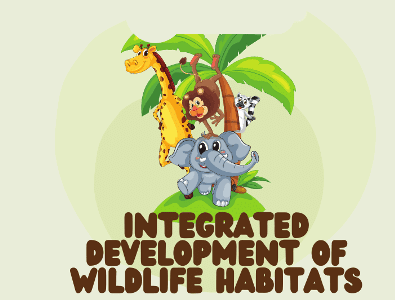PIB Summary- 27th September, 2024 | PIB (Press Information Bureau) Summary - UPSC PDF Download
Integrated Development of Wildlife Habitats Scheme

Context
The Union Cabinet has recently given its approval to continue the Centrally Sponsored Scheme of Integrated Development of Wildlife Habitats (IDWH) for the duration of the 15th Finance Commission cycle, spanning 2021 to 2026.
About IDWH (Integrated Development of Wildlife Habitats)
- Objective: The scheme focuses on enhancing the protection and management of wildlife habitats across India.
Key Activities:
- Habitat restoration.
- Community participation in conservation efforts.
- Addressing human-wildlife conflicts to protect species and local populations.
Components of the IDWH Scheme:
- Support for Protected Areas: Includes National Parks, Wildlife Sanctuaries, Conservation Reserves, and Community Reserves.
- Protection of Wildlife Outside Protected Areas: Expansion of efforts to conserve species outside designated protected areas.
- Recovery Programs: Initiatives to save critically endangered species and improve their habitats.
Subcomponents of IDWH:
- Project Tiger (launched in 1973): Primary goal: Protecting and conserving tiger populations in their natural habitats to prevent extinction.
- Project Elephant (launched in 1992): Focuses on addressing the decline of elephant populations caused by habitat loss and poaching.
- Development of Wildlife Habitat: Focuses on creating and improving habitats to support biodiversity and wildlife conservation.
- Project Dolphin and Project Lion: Targeting the conservation and protection of these key species.
Focus on Keystone Species
The scheme focuses on keystone species such as:
- Tigers
- Elephants
- Cheetahs
- Lions
These species are critical indicators of ecosystem health and biodiversity.
Lesser-Known Species:
- Species Recovery Program under the scheme also supports lesser-known species.
- A total of 16 terrestrial and 6 aquatic species are identified for protection.
Species Listed by IUCN Status:
- Critically Endangered:
Examples: Great Indian Bustard, Hangul, Malabar Civet. - Endangered:
Examples: Red Panda, Gangetic River Dolphin, Nilgiri Tahr. - Vulnerable:
Examples: Asiatic Lion, Snow Leopard, Dugong. - Near Threatened:
Example: Caracal (globally least concern). - Least Concern:
Example: Edible Nest Swiftlet.
Beneficiary Areas:
- The scheme benefits 55 tiger reserves, 33 elephant reserves, and 718 protected areas with zones of influence.
Technological Interventions:
- M-STrIPES: A mobile application for Monitoring Tigers, providing data on tiger sightings and activities.
- Artificial Intelligence (AI): Used in the All-India Tiger Estimation process for species identification.
- Conservation Genetics: Tools such as Standard Operating Procedures (SOP) for translocating tigers based on their genetic composition.
Specific Animal Projects:
- Project Dolphin: Proposed use of Remotely Operated Vehicles (ROVs) and passive acoustic monitoring to track dolphin populations and habitats.
- Project Lion: Reinforced under the vision “Lion@2047: A Vision for Amrut Kaal”, focusing on long-term conservation of lions.
- Project Cheetah: A continuation of the Project Tiger initiative, with expanded areas for introducing cheetahs per the Cheetah Action Plan.
Livelihood Generation:
The continuation of IDWH aims to generate over 50 lakh man-days of employment through engagement in wildlife conservation activities.
Women in Space Leadership Programme
Context
Women in Space Leadership Programme aims to develop a women’s leadership framework to support institutions in strengthening their gender-inclusive practices and policies, specifically around space sciences and allied areas.
Women in Space Leadership Programme:
- Goal: This programme is designed to build a framework that promotes women’s leadership and enhances gender-inclusive practices, particularly in space sciences and related fields.
- Leadership Development: It focuses on fostering leadership qualities among women in space sciences by providing a structured leadership model, with Coventry University as the delivery partner.
- Key Objectives:
- Encourage equitable leadership opportunities for women by recognizing their leadership potential.
- Promote a supportive workplace culture for female leaders, guided by three core principles:
- Intersectionality: Understanding the varied aspects of women’s identities.
- Cultural Sensitivity: Approaching challenges in India through culturally responsive frameworks.
- Leadership Theory: Utilizing theories from both social science and STEM to build female scientists’ confidence in their leadership roles.
UK-India Education and Research Initiative (UKIERI)
- Introduction: Launched in 2006, UKIERI serves as a flagship collaboration between the UK and India, fostering partnerships in education and research.
- Objective: The main aim is to strengthen collaboration in education and research between both nations to support their knowledge aspirations.
- Phases: UKIERI has been implemented over three phases from 2006 to 2022, with the fourth phase launched in 2023.
- Phase 4 Focus: This phase seeks to deepen the bilateral relationship by focusing on education, research, innovation, and addressing global challenges while promoting sustainable development.
FAQs on PIB Summary- 27th September, 2024 - PIB (Press Information Bureau) Summary - UPSC
| 1. What is the Integrated Development of Wildlife Habitats Scheme? |  |
| 2. How does the Women in Space Leadership Programme support women in the aerospace sector? |  |
| 3. What are the key objectives of the Integrated Development of Wildlife Habitats Scheme? |  |
| 4. Who can participate in the Women in Space Leadership Programme? |  |
| 5. What impact does the Integrated Development of Wildlife Habitats Scheme have on local communities? |  |
















